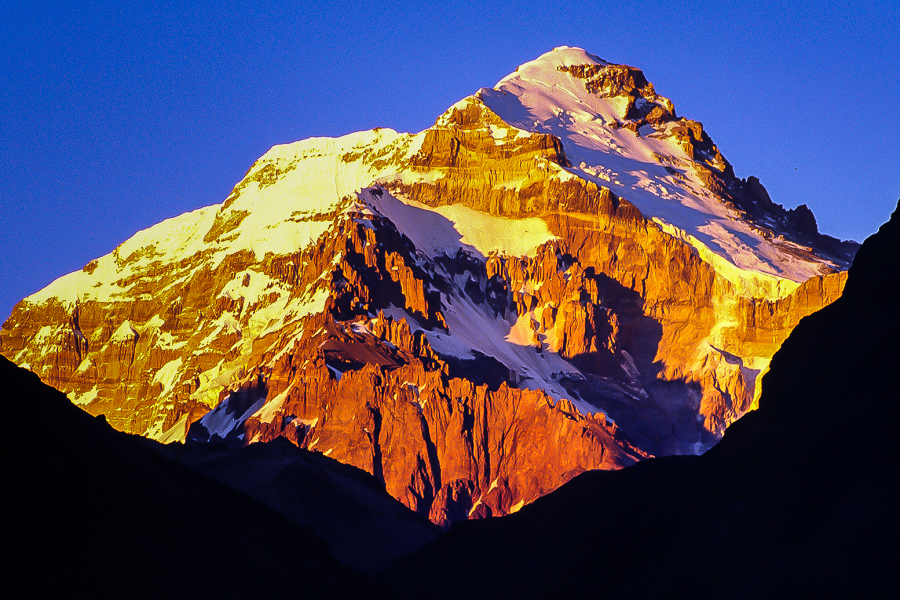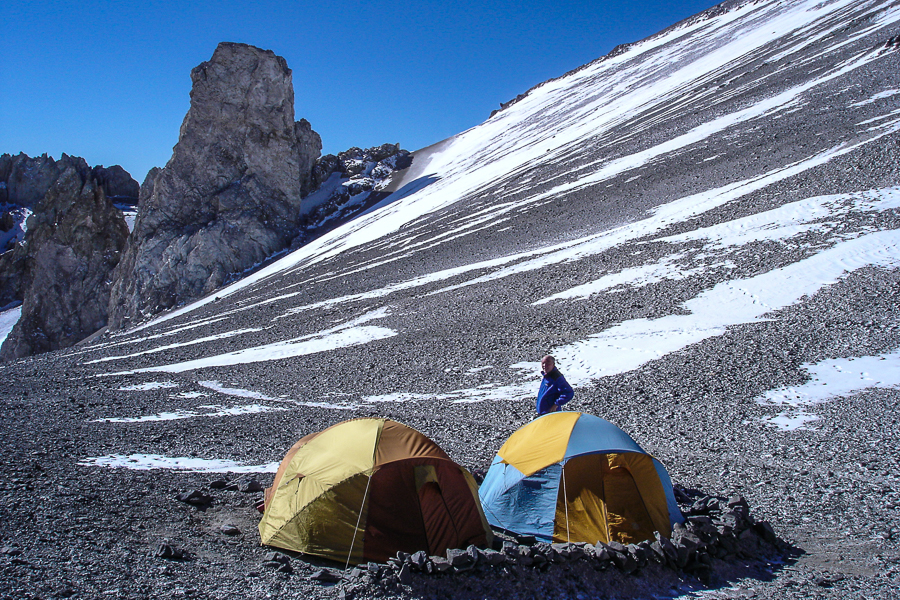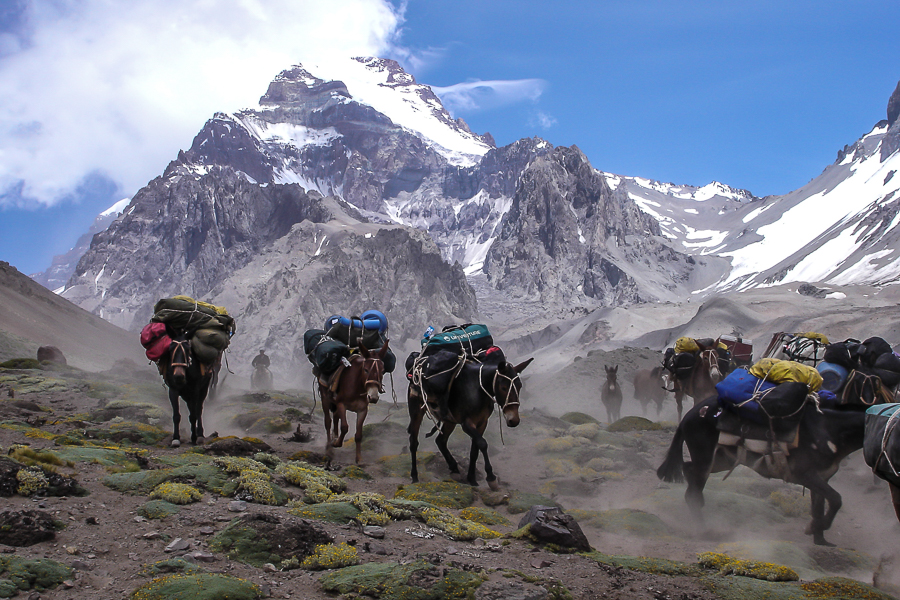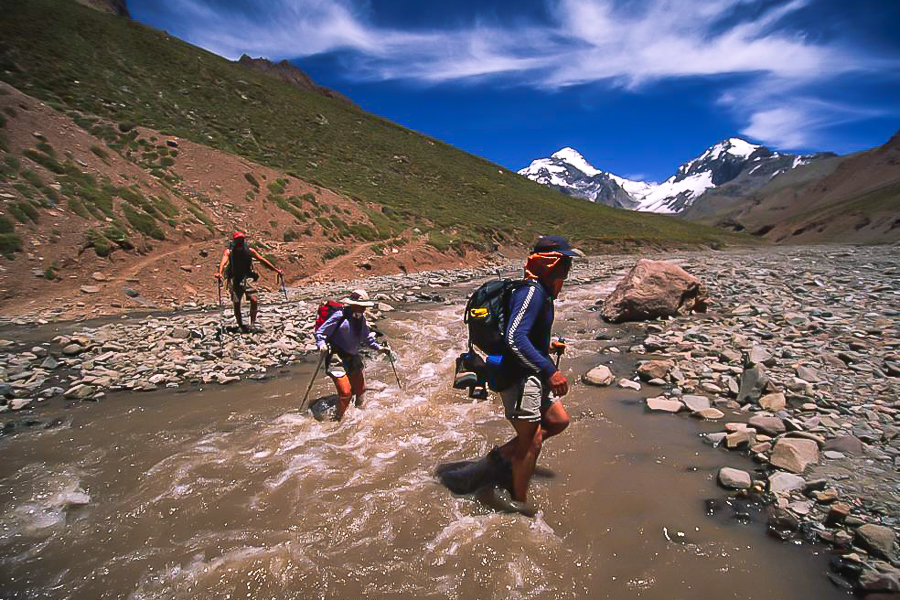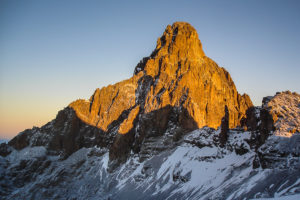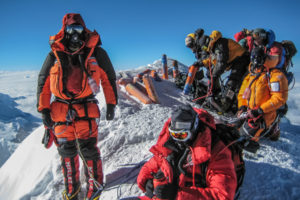Aconcagua, Argentina
Join us for our January 2018 high altitude expedition to one of the great mountains of the world and let us help you stand on the top of Aconcagua, the highest summit in the Western Hemisphere! We will be ascending the Polish Glacier Traverse route on the south-eastern side of Aconcagua and then completing a full traverse to descend via the Horcones Valley “Normal Route” . Canada West Mountain School has been successfully guiding expeditions to Aconcagua since 2000.
$5,450.00
- $5,450. (US $)
Included in the cost of the Aconcagua trip:
- All guiding services and organization
- All food while on the mountain
- All expedition fees and climbing permits
- Transportation to/from Mendoza to the start of the climb
- Mule support in and out to base camp
- Technical climbing and safety equipment as required
- Tents and camp supplies
- Base camp dining tent and meals
- Use of satellite phone
- Two nights lodging in Mendoza (first night and final night)
- One night lodging in Los Penitentes (trailhead)
Not included in the cost of the trip:
- Participants are responsible for their own international transportation to and from Mendoza
- All meals while in Mendoza and while in transit
- Personal clothing and equipment (see equipment list)
- Medical insurance* valid for Argentina
- Visa's and proper travel documents for travel to Argentina
- Lodging while off of the mountain (except as noted)
- Miscellaneous personal costs on and off the mountain
- Tips and gratuities
- Any costs incurred by travel delays, lost or delayed baggage, or for any other reason
- Personal costs on and off the mountain (laundry, alcoholic beverages, internet access, etc.)
- All costs incurred as a result of early return from the climb
- Any costs as a result of rescue or evacuation, including helicopter, mule or transportation costs
Our Aconcagua 2018 expedition follows a non-technical route, though anyone attempting this peak should be in excellent physical shape, and be prepared to carry loads that weigh up to 25 kg's (55 lbs). You will spend much time at altitudes above 5,000 meters and will need to be as fit as possible to help with your performance. Previous multi-day backpacking or mountaineering experience is required
Please contact our office directly to discuss the pre-requisites and training for Aconcagua - 1-888-892-2266.
Location and Logistics
The Aconcagua trip begins and finishes in the city of Mendoza, Argentina. Participants must arrange their own travel to and from Mendoza, via Buenos Aires, Argentina or Santiago, Chile. Once in Mendoza, all transportation and logistical details are pre-arranged. The trip officially starts in Mendoza, Argentina on the first scheduled date.We suggest that you should plan on arriving in Mendoza at least one day in advance though, in order to allow for any flight delays or luggage issues. The first scheduled night (and the last night of the trip) are included in the cost of the trip; any other nights you wish to stay in Mendoza are not included. Please let us know in advance if you woudl like us to book extra nights for you.
If you are flying via Santiago, Chile, when you arrive at the Mendoza airport you will have to clear international customs into Argentina. If you arrive via Buenos Aires, you will clear customs in Buenos Aires first. Clearing customs is generally not an issue in Argentina, though you are not allowed to bring any food that is not in its original packaging (home made goods, loose trail-mix, fresh fruit, etc). Food in original packaging has not been a problem in the past, so if you are bringing any personal snack foods make sure they are in original sealed packaging.
Mendoza is a very relaxed modern and pleasant city. Generally it is a safe city, though travellers should still take the usual common sense approach to travelling.
It is mid-summer there in January - the weather in Mendoza will be very pleasant, temperatures in the mid to upper 30's and sunny. Shorts, light shirts and sandals are recommended for Mendoza. You can leave your bags checked at the hotel as well while you are on the climb, so don't hesitate to bring extras if you are not sure about any gear or clothing items; you can decide down there what to bring and not bring on the mountain.
When you register, a pre-trip package of information will be sent to you, as well as follow-up discussions via phone and email to ensure you are well prepared for your adventure!
Overview of the trip
Our 20-day schedule allows enough time to comfortably acclimatize while on the mountain to give us the best chance of getting to the summit, while also being able to fully enjoy the ascent! This schedule includes 2 extra days in case of inclement weather, if extra rest days are required, to extend the summit window, to deal with potential logistical "glitches" and other unforeseen events, or to do some extra side trips along the way.Day 1 (January 7, 2018)
The team will meet in Mendoza and relax, sort & confirm gear, etc. This night you will sleep low at 730m (2,430'). All team members should plan on being in Mendoza no later than January 7th, though you can also plan to arrive 1 to 2 days earlier, to allow you to deal with unforeseen glitches – lost baggage, delayed flights, etc. This also give you some time to enjoy this beautiful city!Day 2
Everyone will head to the Park Office in Mendoza to obtain the Parks Permit required to enter Aconcagua Park. Each person must be there in person to get their permit. After this is done, the group will go through a full gear check, before driving to Los Penitentes with a private van. This drive is approx. 4 hours on good roads. Everyone will sleep at a hotel in Los Penitentes at 2,700m (8,860') – the first night of acclimatization. Los Penitentes is close to the crest of the Andes, and a few miles from the Chilean/Argentinean border. In the afternoon there are opportunities to go on a short hike to view the SW side of Aconcagua from the trailhead of the Horcones Valley (Normal) route.Day 3
This morning you will load all your gear up on the mules. Each mule carries up to 60 kgs of food, communal gear and personal equipment. Utilizing the mules spares team members from 3 days of carrying heavy loads, a crucial element to preserving strength for the upper mountain. The group will have a short drive to the Punta de Vacas trailhead at 2,350m (7,710'). You will then begin the 3-day hike up the Rio Vacas valley towards our Base Camp at Plaza Argentina. This first hiking day you will travel approx. 12 km to the first camp at Pampas de Las Lenas. This hike is approx. 4-6 hours. The gear travels with the mules and you will have access to it once you arrive at the camp. Your camp that night is at 2,950m (9,680').Day 4
The team will spend the 2nd approach day hiking up the spectacular Vacas valley for 14 kms to the confluence of the Relinchos and Vacas rivers. Here you will camp at Casa Piedra, the “Stone House”. This hike will be approx. 6-8 hours. Again, the gear travels with the mules between camps. Your camp this night will be at 3,250m (10,600'), in an area known for its abundance of wild Guanacos, a smaller version of the Andean Llama.Day 5
This day you will start off with a crossing of the Vacas River, either by foot or on a mule. After this exciting start to the day, you will hike up the Relinchos Valley to Plaza Argentina (PA) at 4,000m (13,180’). This hike will be approx. 10 km and takes 6-8 hours. This will be the last day that your gear is carried by mules!Day 6
This is a very welcomed rest day and allows time to sort gear and prep for the upper mountain. You will sleep at PA at 4000m (13,180').Day 7
This day is used as either another rest day or as a carry-day to move gear and food up to Camp 1 at 5,000m. You will sleep at PA at 4,000m (13,180').Day 8
Move to Camp 1 approx. 4 hours (optional extra rest day used at PA). You will sleep at Camp 1 at 5,000m (16,400”).Day 9
This day is a rest day at Camp 1. You will sleep at Camp 1 at 5,000m (16,400').Day 10
Carry to Camp 2 at 5,500 (18,000’), via the col between Ameghino Peak and Aconcagua. This is a long day, approx. 8 hours return. You will sleep at Camp 1 at 5,000m (16,400').Day 11
Move to Camp 2. This is a shorter day with approx. 4-5 hours of travel. You will sleep at Camp 2 at 5,500m (18,000’).Day 12
Rest day and acclimatization hike, possible carry to Camp 3/Colera Camp. You will sleep at Camp 2 at 5,500m (18,000’).Day 13
Move to Camp Colera at 5,900 m (19,360’).Day 14
This day is scheduled as a possible rest day at Camp Colera or you may choose this as the first summit day if the team is well acclimatized.Day 15
Summit day! You will get up at 2:30 am and have a light meal, fill your water bottles with hot fluids, and head out by 4 am. This day is a long day, approximately 12-14 hours return and 3,000’ (1,000 meters) of vertical climbing. You will possibly begin the day wearing crampons as often snow is encountered at the elevation. On your return you will sleep at Camp Colera at 5,900m (18,900').Day 16
This day will be your first descent day, down to the Plaza de Mulas Basecamp on the Western side of the mountain, in the Horcones Valley. Once in Basecamp at Plaza de Mulas, you will celebrate with a good meal while enjoying the “thick” air back down low! You will spend this night at 4,370 m (14,340 ft).Day 17
The final day is spent hiking back out Horcones Valleys to the trailhead. The final night is spent either back in Penitentes, or if you arrive out early enough you may drive back to Mendoza.Day 18 (January 24, 2018)
This will be a day to drive back to Mendoza and enjoy the fine food and celebrate the climb!IMPORTANT NOTE:
Please note this schedule allows for 2 extra days to be used at any point as required – weather delays, acclimatization needs, logistics, etc. This means that one extra day is held in reserve for a potential weather or logistics delay, so your homebound flights should not be booked for earlier than January 26th, as the final return date to Mendoza may be January 25th.This itinerary is of course dependent on many different factors, including weather, acclimatization rates, weather conditions on the mountain and other factors beyond the control of the guides or of the team. Please remember that this is only a guideline, the actual schedule on the mountain may vary, including camp locations, routes and timing. It is quite possible that a variation of this route may be taken that does not include a traverse of the mountain and has our team descending the Vacas Valley approach route.
Equipment list for Aconcagua expedition
Aconcagua Personal Equipment list - Aconcagua Gear List
- Boots - double plastic mountaineering boots - Scarpa, La Sportiva, etc. Must be properly fitted and broken-in
- Approach boots - sturdy but lightweight hiking boots/shoes suitable for extended hiking on rough trails
- River shoes - lightweight shoes for river crossings. Beach shoes, paddling shoes, old running shoes, etc.
- Sleeping bag - good to a -20 Celsius range. A light silk or cotton liner is recommended.
- Sleeping pad – Therma-rest style pad plus a thin closed-cell foam pad combo is best
- Backpack - internal frame, minimum 70+ litres, suitable for carries of personal gear plus a share of food/communal gear.
- Daypack - approx. 30 litres. This is used for the approach and possibly on summit day.
- Outer shell jacket with hood - Gore-Tex style suitable for all weather conditions.
- Full-zip pants or bibs - Gore-Tex style.
- Long underwear - top and bottom, Poly-pro, Capilene, wool, etc. 1 set light weight + 1 set medium weight
- Hiking pants – lightweight synthetic pants for lower mountain (1 pr)
- Hiking shorts – for approach, cotton or synthetic (1 pr)
- Long pants - synthetic pants for upper mountain/cold weather hiking conditions (1 pr)
- Insulated pants – fleece, pile or down pants for around camp and summit day (1 pr)
- Shirts – suitable for athletic purposes, synthetic (2)
- Gaiters – ensure they fit properly over your boots. Can be insulated but not over-boots (1 pr)
- Gloves - medium weight wool, wind stopper or synthetic style (1 to 2 pr)
- Expedition style gloves or mitts w/removable liners (1 pr)
- Overmitts - shells only that can fit over Expedition gloves for summit day (1 pr)
- Socks - synthetic, wool or wool blend (3-4 pr)
- Liner socks (Poly-pro type) (2-3 pr)
- Warm parka - down, fleece or pile with a hood (1)
- Jacket – lightweight fleece or wind-stopper style (1)
- Sweater or vest - wool, fleece or down (1)
- Toque/insulated hat - wool or fleece (1)
- Balaclava or face mask for wind protection (1)
- Hat with sun visor (baseball cap, etc) (1)
- Bandannas (2)
- Glacier style sunglasses with side shields and nose shields
- Ski goggles
- Headlamp with extra set of batteries
- Personal kit - (toothbrush, foot powder, skin cream, etc.)
- Personal 1st aid (blister kit, medications, etc.)
- Misc. personal items (camera, book, cards, journal, music player, lighter, etc.)
- Water bottles/hydration system - 2 L capacity. Hydration systems with hoses are good for approach only, not summit-day
- Knife - Swiss army style
- Sunscreen and lip screen (min. 30 spf & waterproof)
- Collapsible ski/walking poles (1 pr)
- Crampons - adjusted to your boots (1 pr – supplied if required)
- Ice axe (60 - 70 cm – supplied if required)
- Large duffel bag with lock suitable for storing your pack in for transport on mules.
The equipment that you choose to bring on this climb can directly affect your chances of reaching the summit. Please ensure that you only bring good quality gear that you have had a chance to try out. Also strive to select lightweight gear, though without compromising quality. The total allowed limit for all of your personal gear that will be packed with the mules is 20 kg's.
When organizing your equipment, remember that the conditions on Aconcagua may vary from +30 degrees Celsius in the lower valleys, to -25 degrees Celsius on summit day, with possible extreme high winds and snowfall. Outer clothing should be capable of venting, and you should be able to get in and out of it easily. Inner layers should dry easily and retain warmth when wet (no cotton on the upper mountain). Take into account your own personal warmth rating - if you know that your hands don't warm up easily, or that you sleep cool, or your feet are always cold, keep this in mind!
Review these documents, please send in signed copies of the Waiver and Medical Form before the Expedition start.
Canada West Mountain School Refund Policy - Refund Policy
Canada West Mountain School Waiver - Waiver
Canada West Mountain School Medical Disclosure Form - Medical form
Aconcagua 2018 Pre-planning document - Aconcagua Expedition planning notes
High Altitude briefing document - High Altitude tutorial
Aconcagua Personal Equipment list - Aconcagua Gear List
